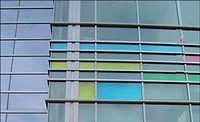AAMA Releases 2015/2016 Market Studies, Predicts Fenestration Industry Trends

SCHAUMBURG, IL - The American Architectural Manufacturers Association (AAMA) has released the AAMA 2015/2016 Study of the U.S. Market for Windows, Doors and Skylights. This bi-annual report delivers information on residential and non-residential market trends and product relationships for windows, doors, skylights, curtain walls and storefronts. Forecasts are based on projections of construction activity as of March 2016.
Residential
Total housing starts continued their growth curve in 2015 with strong gains in both the single- and multi-family segments, between 10 and 12 percent, respectively. For comparison, in 2014, multi-family gained 14 percent, while single-family starts increased by just 4 percent. Going forward, the overall new housing market is expected to continue at a strong level of growth through 2017. Single-family starts are expected to take the lead in 2016 and experience a 14 percent increase. While the Northeast and Midwest regions of the United States have experienced stronger growth in the last two years, the South and West are expected to be more dynamic over that same time period.
Speaking specifically to fenestration, the demand for prime windows improved moderately in 2015 and increased overall by just over 3 percent, driven by continued strong new housing demand, although not as strong as originally forecasted at the beginning of the year. The demand for windows in new housing increased by just over 6 percent in 2015, with double-digit increases forecasted for the next two years as the housing recovery continues. Meanwhile, remodeling and replacement window demand increased modestly again, by just over 1 percent in 2015, with growth in this segment also likely to be somewhat improved in 2016 against the backdrop of strengthening existing home sales.
Residential skylights closed the year with a growth rate of just over 2 percent over 2014 volume. New-construction skylight activity was up 8 percent, while remodeling and replacement skylight activity was up 1 percent versus 2014.
In 2015, residential construction activity experienced moderate growth, with a similar net positive effect on the entry door market. Total volume reflected a 5 percent growth rate versus 2014. Looking forward, growth is expected to continue at a similar pace of 4 percent in both 2016 and 2017.
Non-Residential
Due to the lag of approximately 12 months between contract awards and actual non-residential construction, the relevant metric for 2015 product demand market is the increase in non-residential contract awards of 15 percent. In 2015, the market declined 5 percent overall, and all segments experienced a slight decline. Manufacturing/warehouses declined 7 percent, stores/mercantile building declined 4 percent, while office buildings/hotels/institutional declined 5 percent. Going forward, non-residential contract awards are expected to increase in 2015 throughout 2018.
The 2015 market for non-residential entry doors in the United States has continued to experience growth, up 5 percent over 2014 and up 16 percent since 2013.
Storefront applications and site-fabricated commercial windows combine to account for 54 percent of the non-residential market. Shop-fabricated commercial windows, which include residential type and light commercial windows, as well as architectural windows, represents 24 percent of the market, with curtain wall accounting for the remaining 22 percent of non-residential vision area. All of these categories were up from 2013.
Additional and more detailed information on the residential and commercial fenestration markets is available at the AAMA online store.
Looking for a reprint of this article?
From high-res PDFs to custom plaques, order your copy today!






